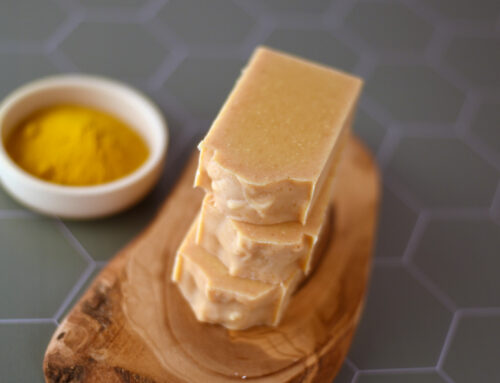Sodium hydroxide is a highly caustic chemical. Contact with skin and eyes can cause severe irritation, burns and blindness.
When handling lye, you must wear safety goggles to protect your eyes and gloves to protect your hands. One splash of lye solution into your eye can permanently damage your eyesight.

Always make sure your environment is free from distractions including pets, children and other family members.
Mixing Your Lye Solution
When making your lye solution, always add your lye to the water- NEVER add your water to the lye or a volcanic eruption can occur. One way to remember this is to say to yourself, ‘snow falls on the lake, lye falls on the water’. Make sure you mix your lye in a well-ventilated area as it does let off fumes when first mixed with water.

Traced Soap
Traced soap is still caustic! Be careful if you have soap on your gloves. Don’t touch your face or skin. If you do, immediately rinse with water.
An Important Note on Vinegar
If you’ve done some research on soapmaking you have heard or come across that vinegar is often used to neutralize lye. Though this is true, you never want to use vinegar on your body to neutralize lye solution you might have splashed on yourself. This is because vinegar neutralizes lye by “flashing it out” and can cause an even greater burn by doing so on your skin.
- If lye has gotten onto your skin, simply rinse off with cold water.
- If lye has gotten into your eye, rinse with water and contact poison control or go ahead a get to the emergency room. Lye can permanently damage your eye causing blindness.
No matter how comfortable you become with soaping, always wear proper eye protection. It only takes one splash to damage your eyesight forever. If you spill lye on the counter or floor you can spray with a vinegar solution to neutralize and wipe up with a paper towel.
Bottom line: If you get lye on your skin, flush with water. (NOT VINEGAR)
If you get lye on a surface, neutralize with vinegar and rinse/wipe up with water.
Keep a copy of an MSDS for sodium hydroxide (your supplier can provide one) nearby and the number to poison control written on it.
An accident probably won’t happen…but if it does…you’ll be ready. Make sure all of your family members (adults and kids) understand the danger of sodium hydroxide and what it can do. Clearly mark all containers that will hold your lye solution so no one wondering through the kitchen on soaping day confuses it for a beverage. Again…not likely…but anything is possible
If you are new to soapmaking, feel free to download our FREE Basic Soapmaking Guide!
Happy (SAFE) Soap Making!
Amanda







Thank you so much for reiterating this I see advice to wash lye splashes on skin with vinegar so often. Vinegar and lye have an exothermic reaction, creating even more heat/burn! Thanks for all the great content ~ Emma
Great content Amanda.
I will be teaching soapmaking and you have been a great asset!
Keep the goos work up!